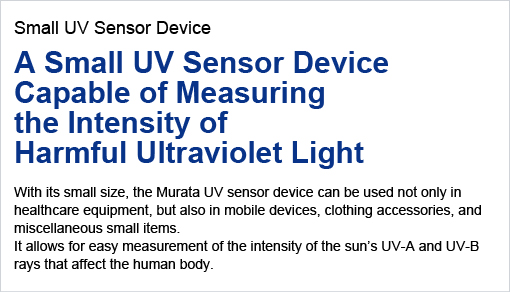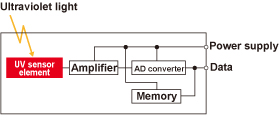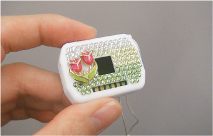
Ultraviolet (UV) ", whose wavelengths are shorter than those of visible rays, are subdivided into 3 categories: UV-A (320-400 nm) , UV-B (280-320 nm) , and UV-C (-280 nm) . UV-C radiation from the sun fails to reach the surface of the Earth as it is absorbed by the stratospheric ozone layer. In some ways, ultraviolet light is useful for the human body. The skin tissue needs it to produce vitamin D, for example. However, excessive exposure is to be avoided since it does more harm than good.
People tend to forget about the risks of exposure to ultraviolet light, however, because it is invisible and because the consequences emerge not immediately upon an exposure, but only as a result of damage accumulated through repeated exposure. This is where the Murata UV sensor device comes in. It can help visualize ultraviolet light. By registering the intensity of UV radiation in figures, it allows the user to notice an attribute of the environment he or she is currently in.Measuring 5.0 x 5.0 mm with a thickness of just 1.5 mm, the new development from Murata can be installed in almost any device. It can be integrated into portable devices and devices installed outdoors.
Featuring independently developed material and structure, the sensor element has measuring accuracy that allows the user to instantly check the current intensity of UV radiation he or she is being exposed to. If the sensor device is integrated into a wearble product, it allows the user to continuously store data on his or her living environment. For example, data can be stored and communicated by combining the UV sensor device with integratedmemory and a wireless communication module. Data stored while wearing the device can be transmitted to a mobile device or a PC, helping the user with health control or beauty care.
Wavelengths detected
by the UV sensor device

UV sensor element

Block diagram of
the UV sensor device

Accessory with an integral
UV sensor device
